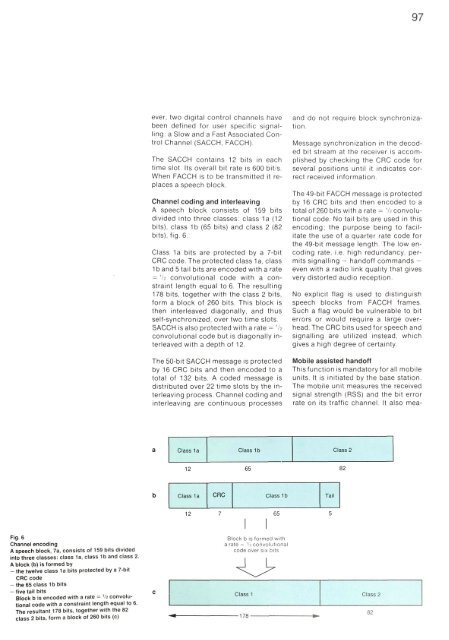Transport Network Development - ericssonhistory.com
Transport Network Development - ericssonhistory.com
Transport Network Development - ericssonhistory.com
- No tags were found...
You also want an ePaper? Increase the reach of your titles
YUMPU automatically turns print PDFs into web optimized ePapers that Google loves.
97ever, two digital control channels havebeen defined for user specific signalling:a Slow and a Fast Associated ControlChannel (SACCH, FACCH).The SACCH contains 12 bits in eachtime slot. Its overall bit rate is 600 bit/s.When FACCH is to be transmitted it replacesa speech block.Channel coding and interleavingA speech block consists of 159 bitsdivided into three classes: class 1a (12bits), class 1b (65 bits) and class 2 (82bits), fig. 6Class 1a bits are protected by a 7-bitCRC code. The protected class 1a, class1 b and 5 tail bits are encoded with a rate= 1 A> convolutional code with a constraintlength equal to 6. The resulting178 bits, together with the class 2 bits,form a block of 260 bits. This block isthen interleaved diagonally, and thusself-synchronized, over two time slots.SACCH is also protected with a rate = Vaconvolutional code but is diagonally interleavedwith a depth of 12.The 50-bit SACCH message is protectedby 16 CRC bits and then encoded to atotal of 132 bits. A coded message isdistributed over 22 time slots by the interleavingprocess. Channel coding andinterleaving are continuous processesand do not require block synchronization.Message synchronization in the decodedbit stream at the receiver is ac<strong>com</strong>plishedby checking the CRC code forseveral positions until it indicates correctreceived information.The 49-bit FACCH message is protectedby 16 CRC bits and then encoded to atotal of 260 bits with a rate = V2 convolutionalcode. No tail bits are used in thisencoding; the purpose being to facilitatethe use of a quarter rate code forthe 49-bit message length. The low encodingrate, i.e. high redundancy, permitssignalling - handoff <strong>com</strong>mands -even with a radio link quality that givesvery distorted audio reception.No explicit flag is used to distinguishspeech blocks from FACCH frames.Such a flag would be vulnerable to biterrors or would require a large overhead.The CRC bits used for speech andsignalling are utilized instead, whichgives a high degree of certainty.Mobile assisted handoffThis function is mandatory for all mobileunits. It is initiated by the base station.The mobile unit measures the receivedsignal strength (RSS) and the bit errorrate on its traffic channel. It also mea-Fig. 6Channel encodingA speech block, 7a, consists of 159 bits dividedinto three classes: class 1a, class 1b and class 2.A block (b) is formed by- the twelve class 1a bits protected by a 7-bitCRC code-the 65 class 1b bits- five tail bitsBlock b is encoded with a rate = V2 convolutionalcode with a constraint length equal to 6.The resultant 178 bits, together with the 82class 2 bits, form a block of 260 bits (c)
















